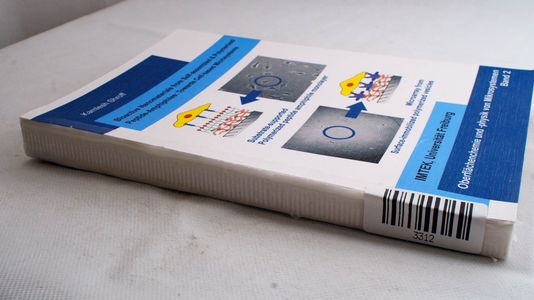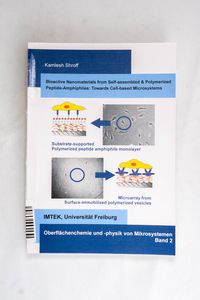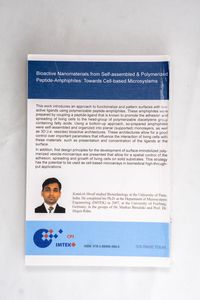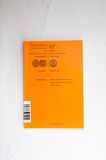
Bioactive Nanomaterials from Self-assembled & Polymerized Peptide-Amphiphiles: Towards Cell-based Microsystems (Oberflächenchemie und -physik von Mikrosystemen) - Shroff, Kamlesh
Netto: 26.55 €28,41€
inkl. MwSt. zzgl. Versand
Bearbeitungszeit: 3 Werktage
Sofort lieferbar (auf Lager)
1x Stück verfügbar
Buchzusammenfassung:
Preface Interesting novel hybrid microsystems are expected, if living cells are combined with artificial materials used in MEMS devices. Possible applications progress from novel cell-based biosensors to drug development and biocompatible surface coatings. The keyparameter that determines such applications is the understanding and manipulation of cellular adhesion on artificial materials (i.e. surfaces). To this, the pursuit for novel bioengineered materials has drawn increasing attention towards the development of synthetic functionalized materials that interact with living systems in a preferred way. For example, engineering bioactive ligands (e.g. small peptide-motifs) into artificial materials is one of the most promising approaches to design bioactive surfaces that are capable of mimicking the natural surrounding of living cells, i.e. the extracellular matrix. An interesting approach is the attachment of functional cell-adhesion ligands, like the well-known “RGD”-peptide to small lipid molecules, thereby forming so-called “peptide-amphiphiles”. These peptide amphiphiles can self-assemble into a variety of 2D and 3D architectures e.g. lipid monolayers and vesicles. The advantage of using such small bioactive building blocks is the high level of control over important parameters such as the ligand surface-presentation (i.e. manipulating the concentration and distance of the bioactive ligand at the surface). In this work, we report on the synthesis and use of polymerizable peptide-amphiphiles, i.e. molecular building blocks that consist of a polymerizable fatty acid, which is linked to a cell-adhesion promoting peptide. The peptide-amphiphile is further used to generate solid supported polymerized monolayers as well as vesicles in solution. The physico-chemical properties of these materials are characterized, as well as the biological activity has been investigated by the use of model cell-lines. We also present a design principle for the development of cell-based microarrays using surface-immobilized polymerized vesicles that expose the molecular recognition site at the outer surface, and hence spatially control the cell-attachment on solid surfaces.
FAQ zum Buch
Bei hydrophilen Substraten wie Glas oder SiO₂ wird die erste Schicht durch Anheben des Substrats durch die Monolage abgeschieden, während bei hydrophoben Substraten wie Graphit oder silanisiertem SiO₂ die Schicht durch Senken des Substrats durch die Monolage gebildet wird. Dies ermöglicht eine präzise Kontrolle der Orientierung und Dicke der ultradünnen Filme durch die Anzahl der Tauchzyklen. Dieses FAQ wurde mit KI erstellt, basierend auf der Quelle: S. 61, ISBN 9783899595895
Die FTIR-Spektren zeigten charakteristische Peaks für die Streckungsvibrationen der Amid-N-H- und C=O-Bindungen im Bereich von 3200–3500 cm⁻¹ und 1500–1600 cm⁻¹. Zusätzlich wurden Peaks für die C-H-Streckungsvibrationen der Methylengruppen im Bereich von 2855–2930 cm⁻¹ sowie ein spezifischer Peak bei 1730 cm⁻¹ für die Carbonylgruppe des Methylesters und bei 1240 cm⁻¹ für die O-CH₂-Gruppen des Oligoethylenglykol-Spacers identifiziert. Dieses FAQ wurde mit KI erstellt, basierend auf der Quelle: S. 78, ISBN 9783899595895
Der Wendepunkt reflektiert ausschließlich Änderungen in der Packung oder Ausrichtung der Monomere an der Wasserdampf-Grenzfläche (Phasenübergangspunkt). Dieses FAQ wurde mit KI erstellt, basierend auf der Quelle: S. 92, ISBN 9783899595895
Bei einer Oberflächenpressung von 20 mN/m wird die maximale positive Abweichung für eine Molarität von χPA2=0,2 beobachtet. Dieses FAQ wurde mit KI erstellt, basierend auf der Quelle: S. 115, ISBN 9783899595895
Abbildung 1-4 zeigt, dass es keine einfache Korrelation zwischen der Oberflächenenergie (Feuchtbarkeit) und der Zelladhesion gibt. Die Daten zeigen signifikante Streuungen und kein einheitliches Ergebnis. Dieses FAQ wurde mit KI erstellt, basierend auf der Quelle: S. 25, ISBN 9783899595895











